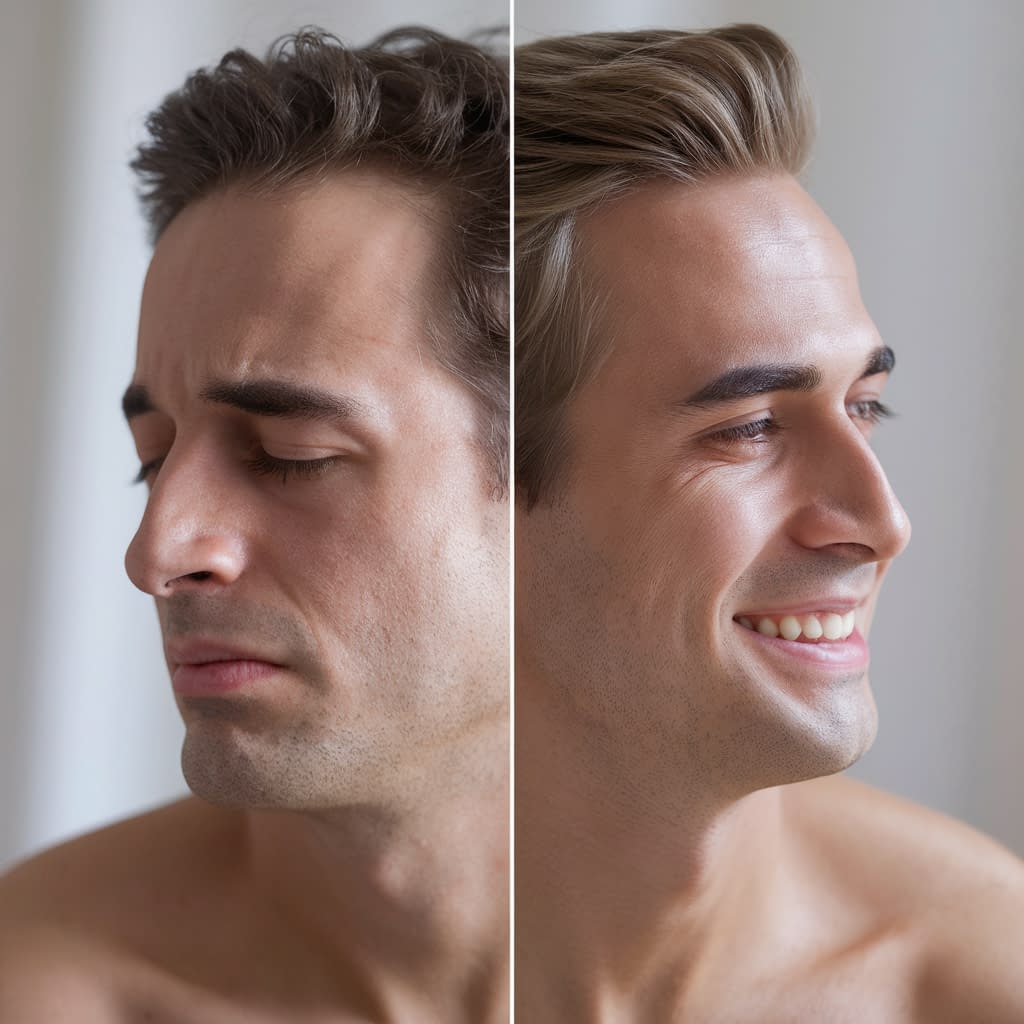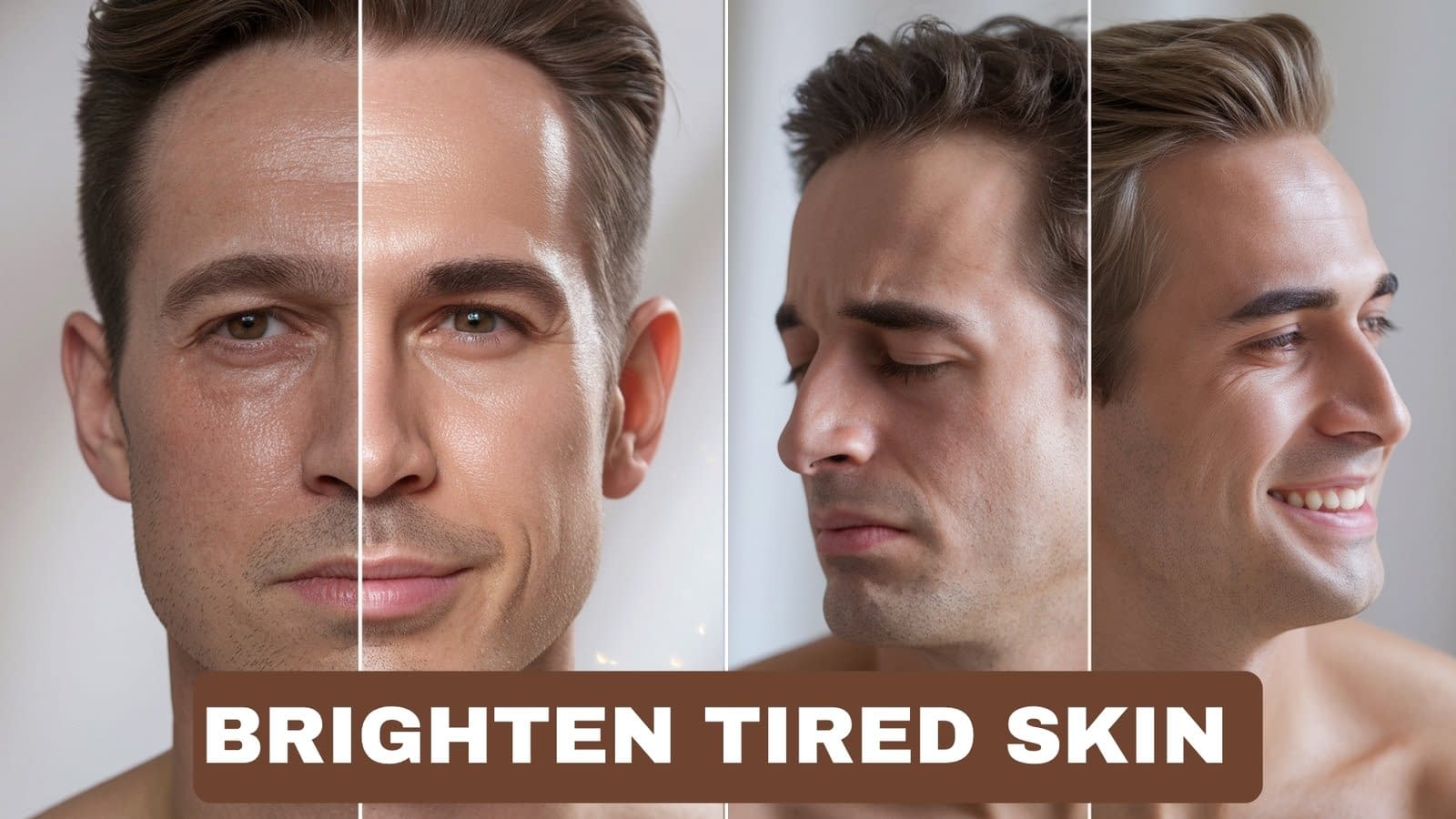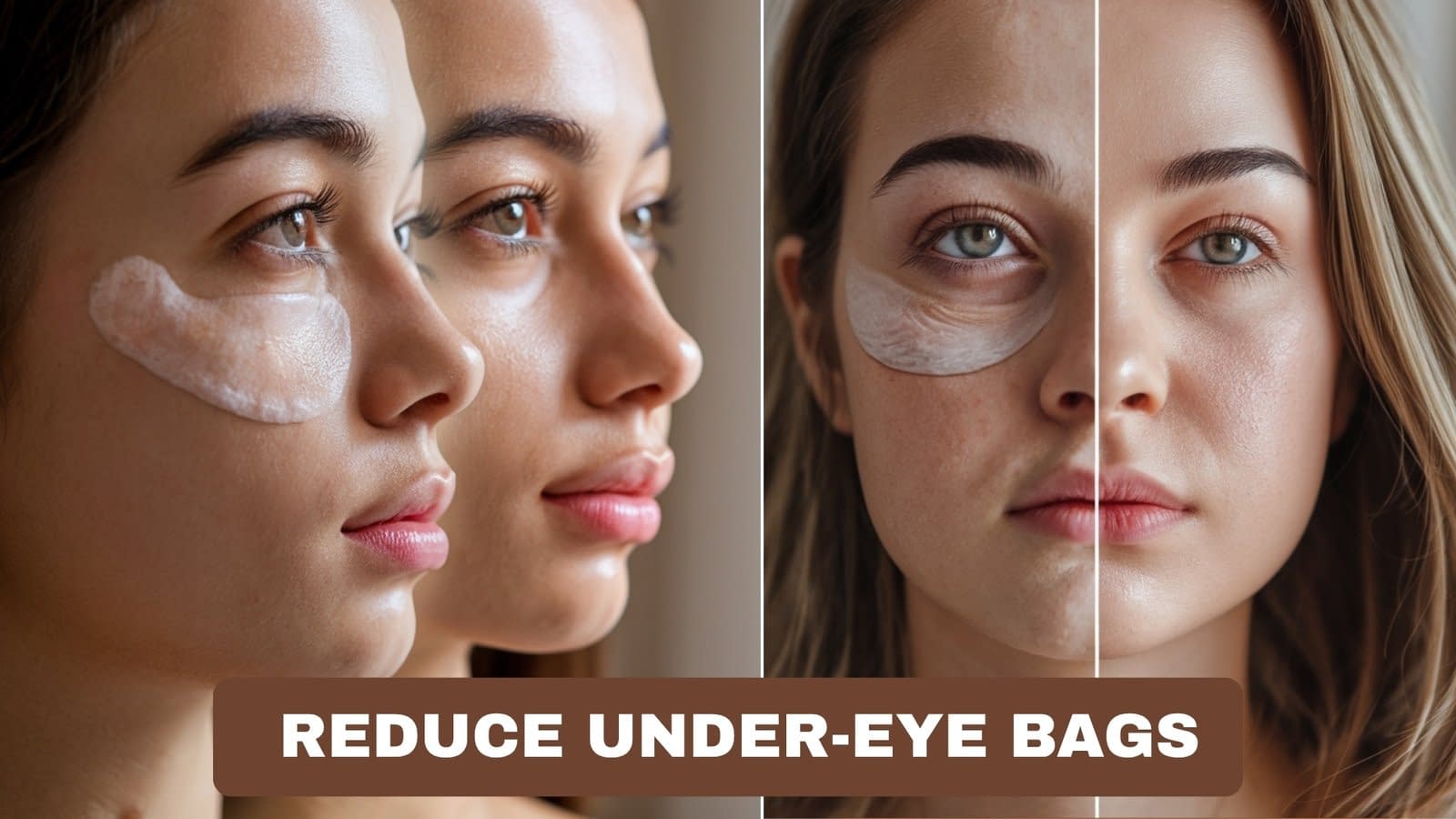Long days, late nights, subway commutes and desk glare — all of it adds up. Tired-looking skin isn’t just cosmetic: it’s a visible signal your body and skin need a small reset. This guide gives you practical, fast fixes you can do right after work, plus the deeper, sustainable habits that actually restore glow over weeks. No complicated rituals, no over-the-top products — just clear, male-friendly steps you can follow whether you’re commuting home, working late, or grabbing a minute in the bathroom before dinner.
Why Your Skin Looks Dull and Tired After Work

Your face shows stressors. Here’s the short version of what’s happening — and why it makes you look worn out.
- Stress & cortisol. Work stress raises cortisol, which affects skin barrier function and inflammation. That means roughness, slower repair and a dull tone.
- Pollution & particles. Commuting and city air deposit particulate matter on your skin. These particles oxidize oils and make skin look grey and clogged.
- Long hours & poor sleep timing. Fewer quality sleep cycles = less repair time when skin renews itself (skin cell turnover slows).
- Screen exposure / blue light. May cause micro-vascular stress and fatigue in skin cells (short-term: tired look; long-term: uneven tone).
- Dehydration from long days. Coffee, air-conditioned offices, and not drinking enough water dry out the skin and flatten its natural “bounce” and radiance.
- Neglected routine. Skipping cleansing, exfoliation, or hydration lets sweat, oil, and dead cells accumulate — dullness follows.
Bottom line: dull skin is the result of physical gunk (pollution, dead cells), reduced hydration and impaired repair. Fixing those three gives the fastest visible lift.
Signs of Fatigued Skin You Shouldn’t Ignore
Recognize the signals so you can treat them properly:
- Dull, uneven tone — the complexion looks “flat” or grey rather than lively.
- Rough texture — skin feels coarse to the touch; makeup (if used) sits unevenly.
- Dark circles & under-eye hollows — not just sleep loss; dehydration and poor circulation contribute.
- Puffiness around eyes and cheeks — fluid retention, long sitting hours or salty meals.
- Fine lines & crepey skin over time — dehydration and oxidative stress make lines appear more visible.
- Frequent breakouts or clogged pores — work-related sweat + not cleansing = congestion that ages skin’s appearance.
If multiple signs are persistent despite basic care, it’s worth stepping up your routine (or seeing a pro — more on that later).
The Science Behind Skin Fatigue and How to Fix It
A quick, non-nerdy breakdown of mechanisms and the fix:
- Hydration deficit: skin needs water inside cells to appear plump. When cells lose water, light scatters irregularly and skin looks flat.
Fix: restore internal and topical hydration (drink, hyaluronic acid, humectants + occlusive to lock it in). - Circulation slowdown: after sitting or stress, microcirculation slows and less oxygen/nutrients reach skin, reducing glow.
Fix: boost blood flow: facial massage, cool splashes, movement/exercise and caffeine topicals for immediate perk. - Oxidative stress: pollution and UV create free radicals that dull and break down collagen.
Fix: antioxidants (vitamin C, green tea) to neutralize radicals and brighten the tone. - Barrier impairment: harsh cleansers or dehydration strip lipids, increasing transepidermal water loss (TEWL).
Fix: gentle cleansing + barrier-repairing products (ceramides, niacinamide).
Understanding these gives you simple levers: hydrate, protect, brighten, increase circulation and restore the barrier.
Quick Post-Work Skincare Routine to Refresh Your Face

This is a 3–5 step routine you can do in under 10 minutes—perfect for right after work or before an evening out.
Goal: remove pollutants, boost circulation, hydrate and protect.
4–Minute Emergency Refresh (fastest)
- Rinse with lukewarm water or splash 3–4 times to wake circulation.
- Use a cleansing wipe or micellar water to remove surface grime if you can’t use a sink (airport/hotel).
- Apply a hydrating mist or essence (aloe, glycerin-containing mist) and pat—don’t rub.
- Tap on a lightweight moisturizer with glycerin or hyaluronic acid. Done.
8–10 Minute Post-Work Refresh (best balance)
- Cleanse (1–2 minutes): use a gentle gel or cream cleanser—massage onto dry skin for 30–45 seconds to loosen grime and pollutants, then rinse. If you sweat a lot, double cleanse: oil/balm first, then a mild water-based cleanser.
- Exfoliate quick (optional, 1 minute, 1–3× weekly): if you have a gentle chemical exfoliant (low % AHA or BHA) — a quick swipe or leave-on pad can instantly brighten by removing surface dead cells. Don’t overdo it—1–3× weekly max.
- Boost circulation (30–60 sec): do a 30–60 second face massage: warm hands, press and sweep upwards from jaw to cheekbones, then from forehead to hairline. Or use a jade roller or gua sha for 1–2 minutes. This immediately helps skin look less puffy and more awake.
- Apply antioxidant serum (Vitamin C) — helps brighten and protect from pollution-induced dullness. Pat in 2–3 drops.
- Moisturize + eye care: a light moisturizer with humectants (hyaluronic acid, glycerin) then dab a small amount of an eye gel/cream along the orbital bone (not in the eye) to reduce puffiness/darkness.
- Optional: caffeine eye roller for immediate de-puffing and brightness before social events.
Night pre-bed addition: a reparative cream or light retinol (if you use retinol and tolerance allows) to help overnight renewal.
Best Natural Ingredients to Brighten and Energize Skin
These ingredients are approachable and effective — many found in affordable products or DIY treatments.
- Vitamin C (ascorbic acid or stable derivatives) — brightens, evens tone, and defends against free radicals. Use in a serum in the AM under SPF.
- Caffeine — constricts microvessels, reducing under-eye puffiness and giving an instant perk. Found in eye gels and creams.
- Aloe vera — cooling, hydrating and soothing for stressed skin. Great as a post-work spritz or gel.
- Green tea (EGCG) — antioxidant and anti-inflammatory; works well in toners or as a cooled compress.
- Hyaluronic acid — powerful humectant that pulls and holds moisture in the skin for immediate plumpness.
- Niacinamide — evens tone, strengthens barrier, reduces redness — good for daily use.
- Licorice extract / arbutin — natural brighteners helpful for evening skin tone over time.
- Glycolic / lactic acid (low %) — gentle exfoliation to remove dead cells and reveal fresher skin (use weekly).
Quick DIY brightening compress: brew strong green tea, chill, soak two cotton pads and place over closed eyes for 5–10 minutes — quick anti-puff, antioxidant boost.
Men’s Exfoliation Tips for Instantly Brighter Skin

Exfoliation = one of the fastest ways to look less tired. Do it right.
Why it works
Dead cells scatter light; removing them reveals newer, smoother cells that reflect light better — instant brightness.
Two methods — pick one based on your skin
A. Chemical exfoliation (recommended for most men)
- Why: gentler, more even, works at follicle level (BHA) for oily/congested skin.
- How: 1–2× per week use a low-concentration AHA (5–10% lactic/glycolic) or BHA (1–2% salicylic). After cleansing, apply the product per instructions. Follow with moisturizer and sunscreen the next morning.
- Caveat: patch test; don’t combine with strong retinol on the same night.
B. Physical exfoliation (manual)
- Why: immediate tactile smoothing — good if you prefer hands-on routines.
- How: use a gentle scrub (fine sugar, oatmeal) or a soft cloth/brush. Do 30–90 seconds in circular motions, then rinse. Limit to 1× weekly if you have normal skin; skip if irritated or inflamed.
- Caveat: avoid harsh scrubs with big abrasive particles — they can micro-tear skin and make it look worse.
Simple at-home enzyme peel (gentle): mashed papaya or pineapple mixed with yogurt — apply for 3–5 minutes and rinse (enzymes loosen dead cells). Patch test first.
Overnight Recovery: How to Wake Up with Rested, Radiant Skin
Night is repair time. Use it well.
Night routine (step-by-step)
- Cleanse to remove the day (pollution and sunscreen). If you wore SPF/heavy grime, double-cleanse (oil/balm then gentle cleanser).
- Apply a reparative serum — niacinamide or a low-strength retinol (if tolerated) to boost barrier repair and cell turnover. If retinol, start 1–2× weekly and build.
- Moisturize well — use a slightly richer night cream or balm to seal hydration. Look for ceramides, fatty acids, peptides.
- Apply eye treatment — a peptide or hyaluronic eye cream to support overnight hydration.
- Optional: Use a thin layer of occlusive (vaseline or similar) on very dry patches to lock in moisture overnight.
Sleep tips that help skin repair
- Stick to consistent sleep times — circadian rhythm matters for cell repair.
- Sleep at least 7–8 hours when possible. Skin cell turnover and collagen synthesis occur during deep sleep.
- Elevate your head slightly to reduce fluid pooling and morning puffiness.
- Wash pillowcases weekly — oils, sweat and dirt accumulate and transfer back to skin.
Nutrition and Hydration Tips to Revive Skin from Within

External fixes help fast — but what you eat and drink determines the baseline.
Hydration
- Aim for steady hydration across the day — 1.5–2.5 L depending on activity. Sip water; avoid large caffeine/alcohol spikes that cause dehydration.
- Add electrolytes or mineral water if you sweat heavily or live in a hot climate.
Foods that boost brightness
- Omega-3 rich foods: salmon, chia, walnuts — reduce inflammation, support barrier.
- Vitamin C-rich foods: citrus, bell peppers, strawberries — supports collagen and brightening.
- Zinc & B vitamins: lean meats, legumes, seeds — support skin healing and energy.
- Antioxidant-rich foods: berries, dark leafy greens, green tea — fight free radicals from pollution.
- Probiotic foods: yogurt, kefir, sauerkraut — support gut-skin axis for clearer skin.
Quick daily menu to support skin
- Breakfast: Greek yogurt + berries + chia.
- Lunch: leafy salad with salmon or chickpeas, olive oil dressing.
- Snack: carrot sticks + hummus, or a piece of fruit.
- Dinner: lean protein, colorful veggies, whole grains.
- Hydration: green tea + water throughout day.
Avoid late-night heavy meals and excessive salt before bedtime to reduce puffiness.
Common Skincare Mistakes That Keep Your Skin Looking Tired
Watch out for these counterproductive habits:
- Over-washing or harsh cleansers — strip oils and leave skin flat.
- Skipping moisturizer — even oily skin needs appropriate hydration. Without it, skin looks dull and rough.
- Skipping SPF — UV damage ages and dulls over time. Use daily SPF 30+.
- Using too many actives at once — acids + retinol + vitamin C in the same session = irritation and rebound dullness. Rotate products.
- Not cleaning tools — dirty razors, pillowcases and phones re-deposit grime.
- Expecting instant miracles — true changes take 4–8 weeks of consistent care.
Lifestyle Habits That Keep Your Skin Looking Fresh Every Day

Small daily habits compound into a bright complexion.
- Move daily. 20–30 minutes of brisk walking or exercise improves circulation and gives skin a natural flush.
- Practice short breathing breaks. 5 minutes of deep breathing reduces cortisol and redness from stress.
- Avoid smoking or reduce it — tobacco constricts vessels and steals skin vitality.
- Limit late-night screens — blue light and poor sleep timing hurt repair.
- Raise water intake on busy days and use a humidifier in dry rooms.
Create a 5-minute morning and evening ritual — consistency beats complexity.
When to See a Dermatologist for Persistent Dullness
Most tired skin improves with routine and lifestyle changes. See a dermatologist if:
- Dullness persists beyond 8–12 weeks despite good care.
- There’s new, persistent discoloration, patchy redness, or unusual texture changes.
- You have frequent, stubborn breakouts or painful bumps that don’t respond to OTC measures.
- Symptoms of underlying disease — sudden skin changes with weight change, systemic symptoms, or persistent inflammation warrant medical review.
A dermatologist can rule out conditions (hypothyroid effects, eczema, rosacea, fungal causes), prescribe professional-strength treatments (chemical peels, prescription retinoids, topical brighteners) and advise targeted procedures (laser, microneedling) if you want faster, clinical-grade results.
Final Words
You don’t need a 12-step regimen to look less tired. Aim for these practical pillars:
- Cleanse gently each evening (and after heavy sweat).
- Exfoliate 1–2× weekly to remove dead cells.
- Hydrate topically and internally — hyaluronic/glycerin in AM/PM; drink water.
- Protect daily with SPF and antioxidants.
- Promote circulation with a quick face massage or roller after work.
- Sleep and movement — the foundations of good skin.
If you only take away three things: rinse off city grime after work, apply a hydrating serum (hyaluronic) + moisturizer, and do a 60–90 second face massage — you’ll see an immediate perk and, over a few weeks, a real improvement in brightness and energy in your skin.








